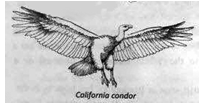
California condors are North America’s largest birds, with wind-length of up to 3 meters. In the 1980s, electrical lines and lead poisoning(铅中毒) nearly drove them to dying out. Now, electric shock training and medical treatment are helping to rescue these big birds.
In the late 1980s, the last few condors were taken from the wild to be bred(繁殖). Since 1992, there have been multiple reintroductions to the wild, and there are now more than 150 flying over California and nearby Arizona, Utah and Baja in Mexico.
Electrical lines have been killing them off. “As they go in to rest for the night, they just don’t see the power lines,” says Bruce Rideout of San Diego Zoo. Their wings can bridge the gap between lines, resulting in electrocution(电死) if they touch two lines at once.
So scientists have come up with a shocking idea. Tall poles, placed in large training areas, teach the birds to stay clear of electrical lines by giving them a painful but undeadly electric shock. Before the training was introduced, 66% of set-freed birds died of electrocution. This has now dropped to 18%.
Lead poisonous has proved more difficult to deal with. When condors eat dead bodies of other animals containing lead, they absorb large quantities of lead. This affects their nervous systems and ability to produce baby birds, and can lead to kidney(肾) failures and death. So condors with high levels of lead are sent to Los Angeles Zoo, where they are treated with calcium EDTA, a chemical that removes lead from the blood over several days. This work is starting to pay off. The annual death rate for adult condors has dropped from 38% in 2000 to 5.4% in 2011.
Rideout’s team thinks that the California condors’ average survival time in the wild is now just under eight years. “Although these measures are not effective forever, they are vital for now,” he says. “They are truly good birds that are worth every effort we put into recovering them. ”
1. California condors attract researchers’ interest because they _________.
| A.are active at night |
| B.had to be bred in the wild |
| C.are found only in California |
| D.almost died out in the 1980s |
| A.blocking condors’ journey home |
| B.big killers of California condors |
| C.rest places for condors at night |
| D.used to keep condors away |
| A.makes condors too nervous to fly |
| B.has little effect on condors’ kidneys |
| C.can hardly be gotten rid of from condors’ blood |
| D.makes it difficult for condors to produce baby birds |
| A.the average survival time of condors is satisfactory |
| B.Rideout’s research interest lies in electric engineering |
| C.the efforts to protect condors have brought good results |
| D.researchers have found the final answers to the problem |
2 . Life in the Clear
Transparent animals let light pass through their bodies the same way light passes through a window. These animals typically live between the surface of the ocean and a depth of about 3,300 feet---as far as most light can reach. Most of them are extremely delicate and can be damaged by a simple touch. Sonke Johnsen, a scientist in biology, says, “These animals live through their life alone. They never touch anything unless they’re eating it, or unless something is eating them.”
And they are as clear as glass. How does an animal become see-through? It s trickier than you might think.
The objects around you are visible because they interact with light. Light typically travels in a straight line. But some materials slow and scatter (散射) light, bouncing it away from its original path. Others absorb light, stopping it dead in its tracks. Both scattering and absorption make an object look different from other objects around it, so you can see it easily.
But a transparent object doesn’t absorb or scatter light, at least not very much. Light can pass through it without bending or stopping. That means a transparent object doesn’t look very different from the surrounding air or water. You don’t see it you see the things behind it.
To become transparent, an animal needs to keep its body from absorbing or scattering light. Living materials can stop light because they contain pigments (色素) that absorb specific colors of light. But a transparent animal doesn’t have pigments, so its tissues won’t absorb light. According to Johnsen, avoiding absorption is actually easy. The real challenge is preventing light from scattering.
Animals are built of many different materials---skin, fat, and more---and light moves through each at a different speed. Every time light moves into a material with a new speed, it bends and scatters. Transparent animals use different tricks to fight scattering. Some animals are simply very small or extremely flat. Without much tissue to scatter light, it is easier to be see-through. Others build a large, clear mass of non-living jelly-like (果冻状的) material and spread themselves over it.
Larger transparent animals have the biggest challenge, because they have to make all the different tissues in their bodies slow down light exactly as much as water does. They need to look uniform. But how they’re doing it is still unknown. One thing is clear: for these larger animals, staying transparent is an active process. When they die, they turn a non-transparent milky white.
1. According to Paragraph 1,transparent animals .| A.stay in groups | B.can be easily damaged |
| C.appear only in deep ocean | D.are beautiful creatures |
| A.silently | B.gradually |
| C.regularly | D.completely |
| A.change the direction of light travel | B.gather materials to scatter light |
| C.avoid the absorption of light | D.grow bigger to stop light |
| A.move more slowly in deep water |
| B.stay see-through even after death |
| C.produce more tissues for their survival |
| D.take effective action to reduce light spreading |



